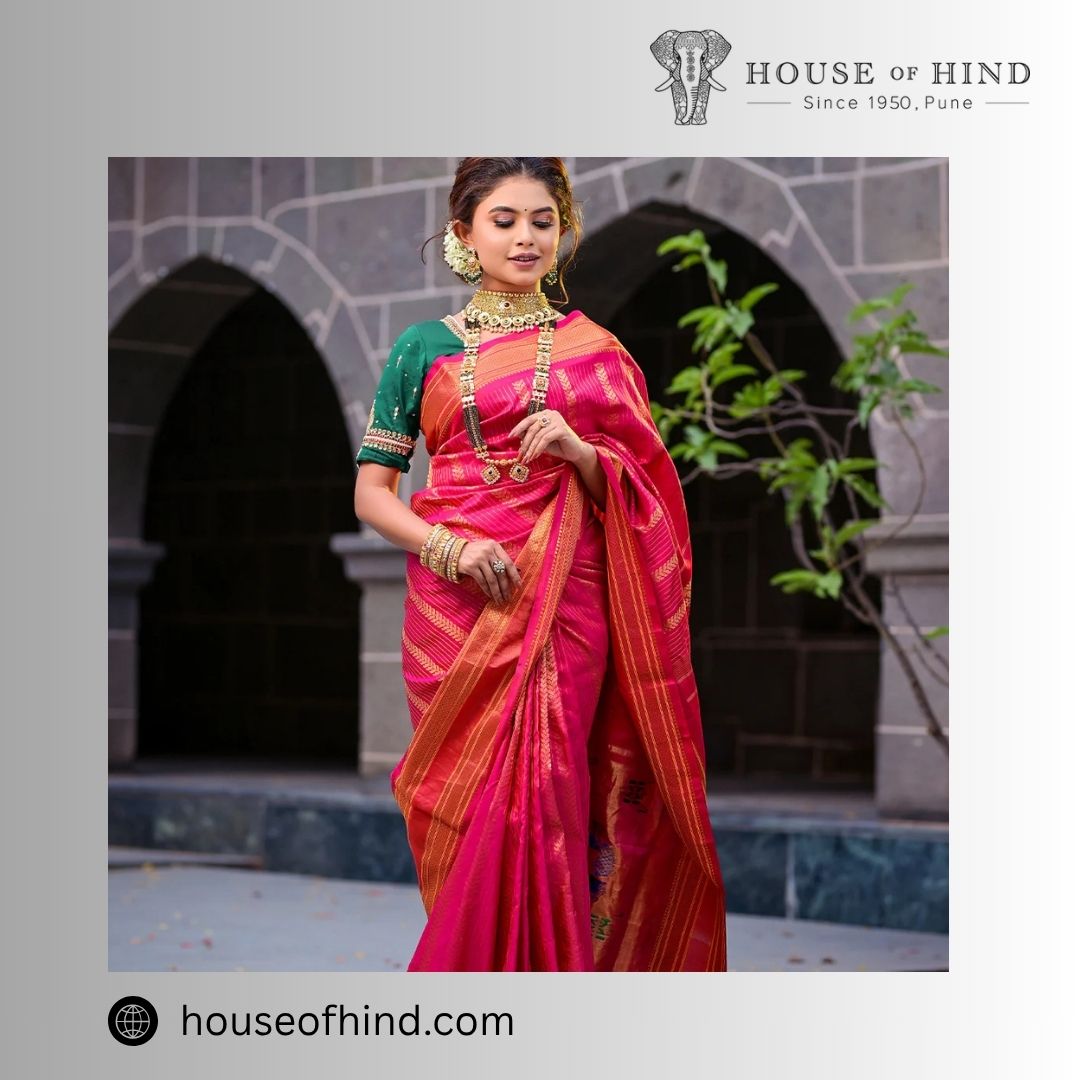
 India’s cultural identity is beautifully woven into its textiles—and among them, the Paithani saree stands as a shining emblem of elegance, heritage, and craftsmanship. Often referred to as the ‘Queen of Silks,’ the Paithani saree has transcended generations, becoming not only a traditional attire but a proud symbol of Maharashtra’s royal legacy. Worn by queens and admired by modern women alike, it embodies centuries of artistry that continues to dazzle the world with its intricate design, radiant colors, and pure silk grandeur.
India’s cultural identity is beautifully woven into its textiles—and among them, the Paithani saree stands as a shining emblem of elegance, heritage, and craftsmanship. Often referred to as the ‘Queen of Silks,’ the Paithani saree has transcended generations, becoming not only a traditional attire but a proud symbol of Maharashtra’s royal legacy. Worn by queens and admired by modern women alike, it embodies centuries of artistry that continues to dazzle the world with its intricate design, radiant colors, and pure silk grandeur.
A Glimpse into the Origin of the Paithani Saree
The story of the Paithani saree begins in the ancient city of Pratishthana—modern-day Paithan—situated on the banks of the Godavari River in Maharashtra. Known for its rich culture and art, Paithan became a center of silk weaving during the Satavahana dynasty around the 2nd century BC. The saree was named after this historic town and soon gained prominence as a luxury fabric for royalty.
Back then, these sarees were woven with real gold and silver threads, making them worthy of queens and noblewomen. Over time, the tradition evolved, and each motif began to symbolize prosperity, nature, and devotion. From peacocks symbolizing grace to lotus flowers representing purity, every detail carried cultural meaning.
Royal Patronage and the Rise of Paithani
The Paithani saree’s ascent to royal status occurred during the reign of the Peshwas of Pune. The Maratha queens, especially Rani Lakshmibai of Jhansi and Devi Ahilyabai Holkar, were known to wear exquisite Paithanis at court and during important ceremonies. These sarees became symbols of affluence and power, gracing royal wardrobes and temples alike.
The craftsmanship involved in weaving these sarees is nothing short of extraordinary. Every thread, from silk to zari, is handwoven with immense care and devotion. The zari borders and pallus depict motifs like mor (peacock), asawali (floral vine), and bangdi mor (peacock within a bangle)—each representing Maharashtra’s vibrant spirit.
Even centuries later, the same traditional techniques are practiced by artisans in Paithan and Yeola, ensuring that every saree carries the unmatched grandeur of royal craftsmanship.
The Unique Craftsmanship of Paithani Sarees
What makes a Paithani saree truly remarkable is its handloom weaving technique. Unlike other sarees that are embroidered or printed, Paithanis are woven into art.
Pure Silk Threads: Only the finest mulberry silk is used for the base.
Zari Borders: Traditionally woven with pure gold and silver threads.
Motifs and Pallus: Designed using a tapestry technique, ensuring that both sides look identical.
Vibrant Colors: Natural dyes and rich dual tones like peacock blue, magenta, parrot green, and wine red define the saree’s royal appeal.
The precision and patience required to weave a single saree are astounding—it can take anywhere between 30 days to 6 months to complete one, depending on complexity. Each creation reflects the artisan’s legacy, skill, and dedication to preserving Maharashtra’s cultural identity.
Paithani Saree and Its Modern Evolution
While the traditional Paithani saree has deep historical roots, its relevance in modern times has only grown stronger. Fashion designers and textile enthusiasts across India have reimagined it for the contemporary woman—balancing tradition with modern aesthetics.
Lighter silk variants, fusion color palettes, and minimal zari patterns now appeal to younger audiences who want to carry heritage with ease. Yet, the essence of the saree—the meticulous weaving and cultural symbolism—remains untouched.
Today, you’ll see Paithanis draped by brides, film stars, and even global influencers, making it a truly versatile and enduring piece of Indian fashion.
Paithani Saree Online: The Digital Revival of a Traditional Masterpiece
In the age of digital shopping, the allure of the Paithani has found a new audience. Authentic handcrafted sarees that were once available only in select parts of Maharashtra are now accessible to buyers worldwide through platforms offering Paithani saree online.
Online stores like House of Hind bridge the gap between artisans and customers, ensuring transparency, quality, and authenticity. Buyers can explore different types of Paithanis—Yeola Paithani, Plain Paithani, and Brocade Paithani—along with detailed craftsmanship insights.
The rise of e-commerce has not only boosted sales but also empowered weavers. Many artisans now directly supply to platforms that promote their work globally, keeping the 2,000-year-old tradition alive in the digital age.
The Cultural and Emotional Connection of the Paithani Saree
For Maharashtrian women, owning a Paithani saree isn’t just about fashion—it’s about heritage. It’s often part of a bridal trousseau, gifted during weddings, festivals, or milestone celebrations. The saree becomes a family heirloom, passed down from one generation to another, symbolizing continuity, love, and pride.
During festivals like Diwali, Makar Sankranti, and Gudi Padwa, the Paithani is worn with devotion and grace. Its bright hues and zari shimmer perfectly complement the joyous spirit of these occasions. The saree isn’t merely worn—it’s celebrated.
Preserving the Legacy of Paithani Weaving
Despite modernization, Paithani weaving remains a labor of love that requires skill and patience. Several initiatives by the Maharashtra government, NGOs, and design institutions are working to safeguard this art form.
Efforts include:
Training programs for new weavers.
Cooperative societies that ensure fair wages.
Design innovation workshops that blend tradition with modern trends.
Promotion through exhibitions and online platforms to increase awareness.
Such initiatives not only preserve the craft but also uplift rural communities, giving artisans financial stability and recognition on a global scale.
Why the Paithani Saree Continues to Rule the Fashion World
Despite the advent of machine-made fabrics, the Paithani saree holds an irreplaceable place in Indian fashion. Its richness, authenticity, and timeless charm make it a wardrobe essential for every woman who appreciates fine craftsmanship.
From royal courts to red carpets, this saree’s presence remains unchallenged. Its ability to blend seamlessly with both traditional and modern styling has made it a must-have for collectors and connoisseurs alike.
No matter how much fashion evolves, the Paithani’s appeal lies in its heritage—a story that connects the past, present, and future through threads of silk and gold.
How to Identify an Authentic Paithani Saree
As the popularity of Paithanis grows, so does the presence of counterfeit products. To ensure that your investment goes into a genuine handwoven piece, here’s what to look for:
Reverse Side Check: Authentic Paithanis look identical on both sides.
Zari Test: Pure zari has a subtle gold sheen and doesn’t peel or flake.
Weaving Marks: Minor irregularities are signs of handloom work.
Origin Tag: Look for GI (Geographical Indication) tags from Paithan or Yeola regions.
By buying from trusted handloom outlets or verified online stores, you ensure that you’re contributing to the livelihood of genuine artisans.
Buy Paithani Saree: Celebrate Maharashtra’s Legacy
If there’s one garment that encapsulates the essence of Maharashtra’s artistry, pride, and regal culture, it’s the Paithani saree. Owning one means owning a slice of history—a connection to the queens and weavers who shaped India’s textile identity.
You can explore a wide range of authentic designs and Buy Paithani saree from House of Hind, where each piece is crafted with heritage, precision, and passion. These sarees are not just fashion statements—they are timeless heirlooms that celebrate Indian craftsmanship in its purest form.
By investing in a Paithani, you’re not just embracing elegance—you’re helping preserve an art that has stood the test of time for over two millennia.
Conclusion: A Drape of Royalty and Pride
The Paithani saree is much more than a piece of clothing—it’s a woven expression of Maharashtra’s royal past, artistic legacy, and enduring beauty. From ancient palaces to modern celebrations, its golden threads continue to tell stories of power, devotion, and grace.
As generations change, trends come and go, but the allure of the Paithani remains eternal. Whether you wear it for a wedding, a festival, or simply to honor tradition, this saree will always be a symbol of India’s rich heritage and cultural pride.
So, the next time you wish to adorn yourself in something truly regal and timeless—choose the Paithani saree. Because when you wear it, you don’t just wear silk and zari—you wear history itself.


